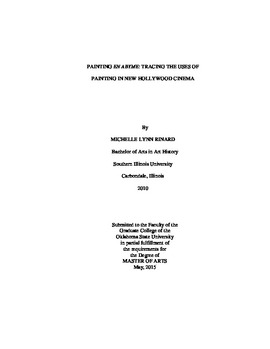| dc.description.abstract | In the period of the New Hollywood in cinema, four directors created films that incorporated paintings and artworks within their scenes: Mike Nichols� The Graduate (1967); John Frankenheimer�s Seconds (1966); Stanley Kubrick�s A Clockwork Orange (1971); and Paul Mazursky�s An Unmarried Woman (1978). In four close readings, I demonstrate that these filmmakers incorporated painting to contribute to the emotions and narrative, to reflect the institutional power or ideological positions of characters and organizations, and as cultural or anti-cultural capital. The incorporation of painting in film creates a mise en abyme, doubling the forms and meanings of art within the film medium. The use of painting in cinema in the period between 1966 and 1978 is characteristic of an artistic trend in New Hollywood filmmaking. Earlier uses of art in film were overwhelmingly narrative and diegetic, while in New Hollywood film it becomes a mode of editorializing and extra diegetic commentary. During the 1960s and �70s, American cinema was in a transitional period and a new director-based auteurism. Filmmakers influenced by the European New Wave, characterized by a group of prominent artistic filmmakers of the late 1950�s and 1960�s, were part of a youth generation and counterculture, and emerged from places outside the industry, including theater, television, and film schools. In my chapters, I develop an art historical analysis of commercial and narrative cinema, looking at the use of painting through the lens of art historical methods, theories, and close looking. The artists and artworks are included in these films by filmmakers as a commentary on the art world in juxtaposition with the world of cinema. The use of painting creates a dialogue with an art literate audience, which reveals the art prowess of the directors themselves, who are creating their own works of art. | |
